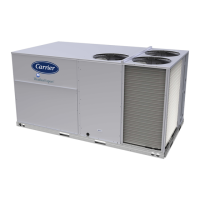44
Heating Troubleshooting
Use the unit SystemVu™ Display or a CCN device to view the
heating status display and the heating diagnostic display (see
Appendices) for information on the heating operation. Check
the current alarms and alarm history for any heating alarm
codes and correct any causes. (See Table 16.) Verify any
unique control configurations per installed site requirements or
accessories. If alarms conditions are corrected and cleared, op-
eration of the heat stages and indoor fan may be verified by us-
ing the Service Test mode. (See Table 4.)
GAS HEAT (48LC UNITS)
See Table 21 for general gas heating service analysis. See
Fig. 22 for service analysis of the IGC board logic. Check the
status LED on the IGC board for any flashing alarm codes and
correct any causes. (See Table 22 on page 46.)
ELECTRIC HEAT (50LC UNITS)
See Table 23 on page 47 for electric heating service analysis.
Table 21 — Gas Heat Service Analysis
PROBLEM CAUSE REMEDY
Heat will not turn on Unit is NOT configured for heat. Check heating configurations using the SystemVu Display
Burners will not ignite
Active alarm.
Check active alarms using SystemVu Display and the IGC
flash codes.
No power to unit. Check power supply, fuses, wiring, and circuit breakers.
No power to IGC (Integrated Gas Control). Check fuses and plugs.
Heaters off due to time guard to prevent short
cycling.
Check using SystemVu Display and the IGC flash codes.
Thermostat or occupancy schedule set point not
calling for Cooling.
Check using SystemVu Display.
No gas at main burners.
Check gas line for air and purge as necessary. After
purging gas line of air, allow gas to dissipate for at least
5 minutes before attempting to re-light unit.
Water in gas line. Drain water and install drip.
Inadequate heating
Dirty air filters. Replace air filters.
Gas input too low.
Check gas pressure at manifold. Refer to gas valve
adjustment.
Thermostat or occupancy schedule set point only
calling for W1.
Allow time for W2 to energize or adjust setpoints.
Unit undersized for load. Decrease load or increase of size of unit.
Restricted airflow.
Remove restriction. Check SAT compared to the SAT
heating limits.
Too much outdoor air.
Check economizer position and configuration. Adjust
minimum position using SystemVu Display.
Limit switch cycles main burners.
Check rotation of blower, thermostat heat anticipator
settings, and temperature rise of unit. Adjust as needed.
Poor flame
characteristics
Incomplete combustion (lack of combustion air)
results in: Aldehyde odors, CO, sooting flame, or
floating flame.
Check all screws around flue outlets and burner
compartment. Tighten as necessary.
Cracked heat exchanger. Replace.
Unit is over-fired, reduce input. Adjust gas line or manifold
pressure.
Check vent for restriction. Clean as necessary.
Check orifice to burner alignment.
Burners will not
turn off
Unit is in Minimum on-time. Check using SystemVu Display and the IGC flash codes.
Unit running in Service Test mode. Check using SystemVu Display.
Main gas valve stuck. Turn off gas supply and unit power. Replace gas valve.

